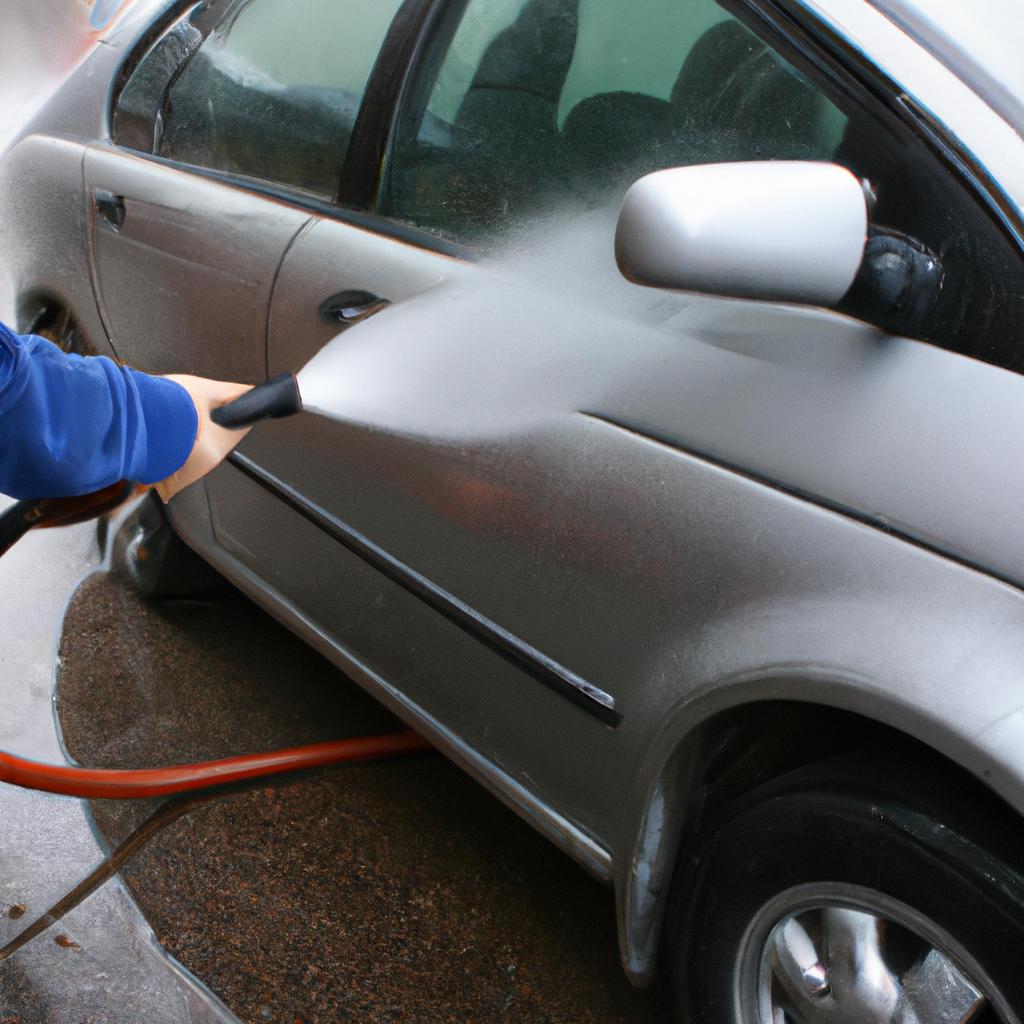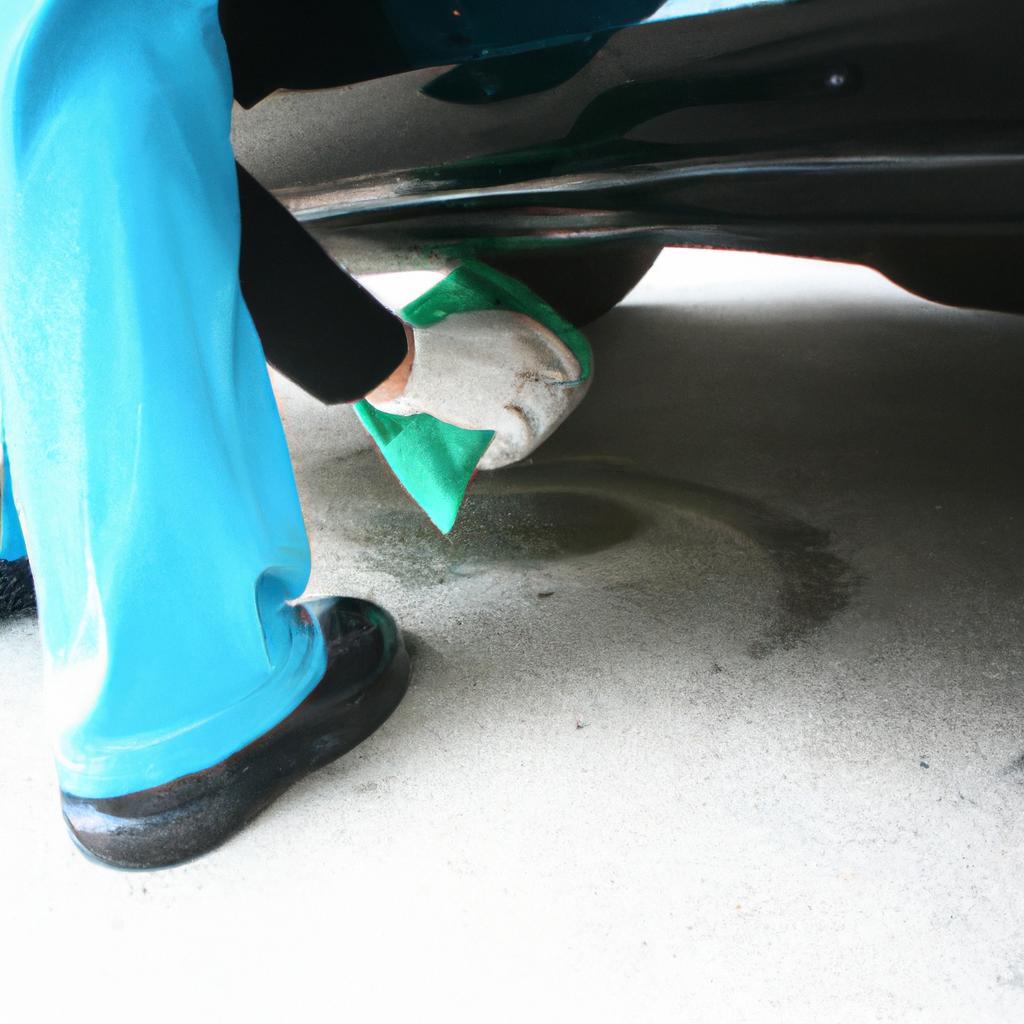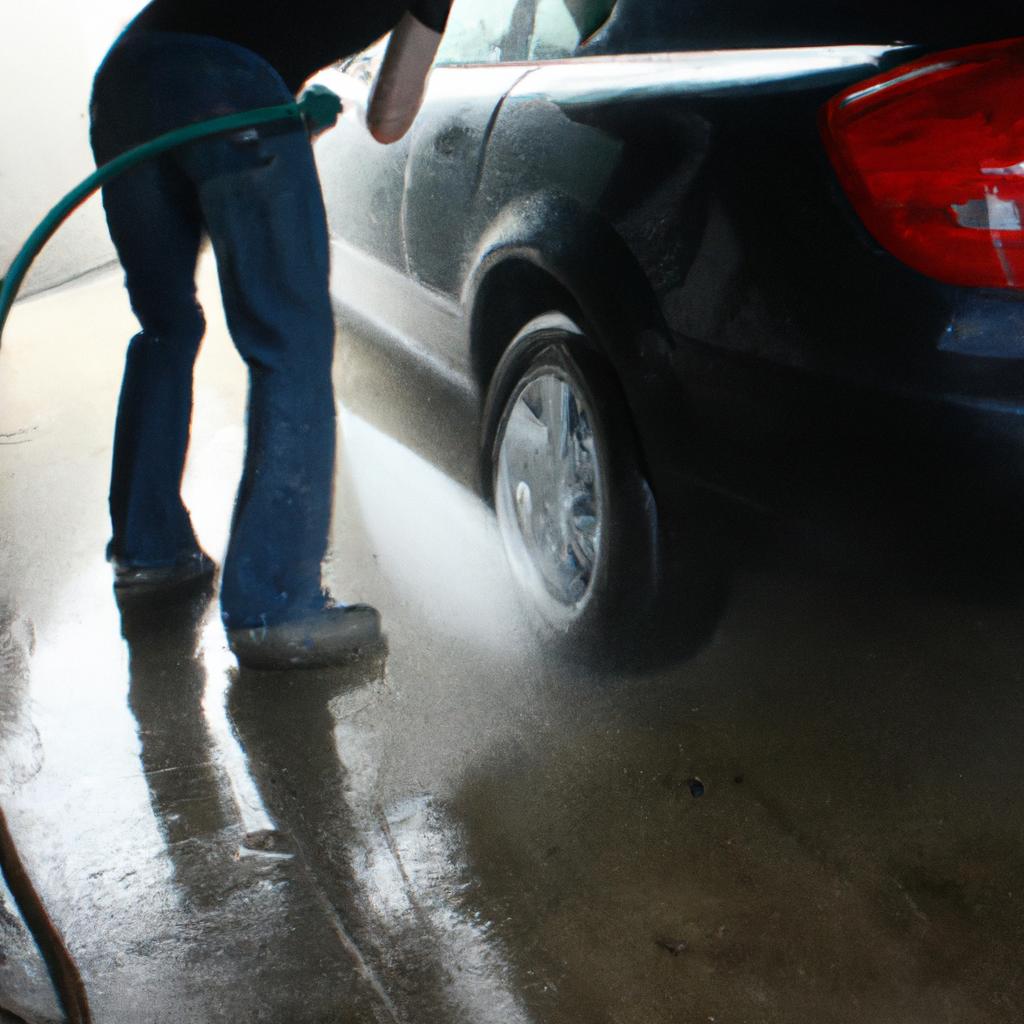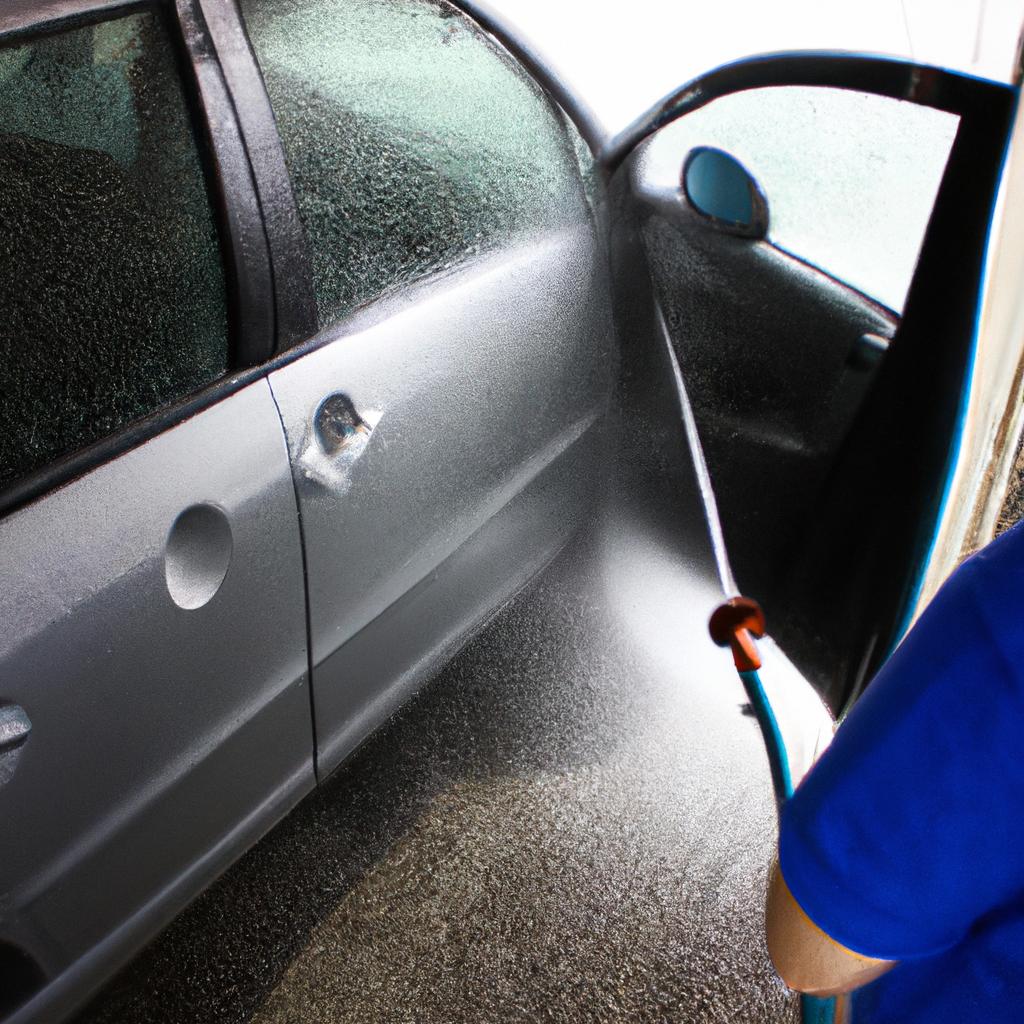The maintenance and care of vehicles are essential aspects to ensure their longevity and optimal performance. One often overlooked area in car maintenance is the underbody, which is prone to accumulating dirt, debris, and corrosive substances from daily driving. Neglecting proper cleaning and protection of the underbody can lead to potential safety hazards as well as costly repairs. This article aims to explore the importance of underbody protection in car washes as a means to enhance safety for both vehicle owners and car wash operators.
For instance, consider a hypothetical scenario where an individual regularly drives through muddy terrains without taking necessary precautions to clean the underbody afterward. Over time, mud accumulates on various components such as suspension systems, brake lines, and exhaust pipes. The presence of this buildup not only compromises the integrity of these parts but also increases the risk of corrosion and subsequent damage. In extreme cases, neglecting underbody care may result in failures or malfunctions that could endanger occupants’ lives or cause accidents on the road.
To mitigate these risks, it is crucial to incorporate thorough underbody washing procedures into standard car wash practices. By understanding the significance of targeting the undercarriage during cleaning sessions, car wash operators can contribute significantly towards preserving vehicle condition and minimizing safety concerns associated with neglected underbody care.
Underbody protection in car washes involves a combination of techniques and products aimed at removing dirt, debris, and corrosive substances from the underside of vehicles. High-pressure water jets, specialized cleaning agents, and rotating brushes are commonly utilized to dislodge and eliminate buildup effectively. Additionally, some car wash facilities offer additional services such as rustproofing or applying protective coatings to further safeguard the underbody against potential damage.
By incorporating underbody protection into their car wash routines, operators can help vehicle owners avoid costly repairs caused by corrosion or component failures. Furthermore, it enhances safety for both drivers and passengers by reducing the risk of accidents resulting from compromised vehicle integrity.
Vehicle owners should also prioritize regular underbody cleaning to maintain their vehicles’ longevity and performance. While some individuals may choose to clean the undercarriage themselves using various tools and cleaning solutions, professional car wash facilities equipped with specialized equipment offer more efficient and thorough cleaning results. The convenience of these establishments ensures that proper underbody care is not overlooked or neglected due to time constraints or lack of knowledge.
In conclusion, understanding the importance of underbody protection in car washes is vital for both vehicle owners and car wash operators. By incorporating thorough undercarriage cleaning procedures into standard practices, operators contribute significantly towards preserving vehicle condition and minimizing safety concerns associated with neglected underbody care. Vehicle owners who prioritize regular underbody cleaning can ensure the longevity and optimal performance of their vehicles while reducing the risk of accidents caused by compromised vehicle integrity.
Importance of Underbody Protection
Car washes have long been a popular choice for vehicle owners seeking to maintain the cleanliness and appearance of their automobiles. However, while car washes offer convenience and efficiency, it is crucial to recognize the importance of underbody protection in ensuring both the safety and longevity of vehicles.
To illustrate this point, consider the case of an unsuspecting driver who frequented a local car wash without paying much attention to underbody care. Over time, debris such as dirt, gravel, and road salt accumulated on the underside of their vehicle. This buildup eventually resulted in corrosion and damage to vital components like the exhaust system and suspension parts. Consequently, costly repairs were required to rectify these issues.
Underbody protection plays a pivotal role in preventing similar situations from occurring. By providing a thorough cleaning process that targets hard-to-reach areas underneath vehicles, car washes equipped with underbody wash systems effectively remove harmful substances that can cause corrosion or impair performance. To emphasize its significance further, let us explore some key reasons why underbody protection should be prioritized:
- Corrosion prevention: The accumulation of dirt, mud, salt, and other corrosive agents on the undercarriage can lead to rust formation over time. Proper underbody washing removes these contaminants and helps prevent corrosion.
- Enhanced safety: A clean undercarriage contributes to improved traction by eliminating the presence of slippery substances that could compromise tire grip on wet roads.
- Extended lifespan: Regularly maintaining the cleanliness and condition of critical components beneath vehicles can significantly prolong their lifespan.
- Preservation of resale value: Vehicles with well-maintained underbodies are more likely to retain their value when it comes time for resale.
To highlight this information visually and evoke an emotional response in our audience, we present a table that outlines potential consequences when neglecting proper underbody care:
| Neglected Underbody Care | Potential Consequences |
|---|---|
| Corrosion | Rust formation |
| Reduced traction | Increased risk of accidents on wet roads |
| Component failure | Costly repairs and replacements |
| Decreased resale value | Lower trade-in or sale price |
In summary, underbody protection is not merely a luxury but an essential aspect of vehicle maintenance. Neglecting this crucial area can lead to corrosion, compromised safety, decreased lifespan of components, and diminished resale value. In the following section about “Common Underbody Hazards,” we will explore specific hazards that necessitate comprehensive underbody care.
Common Underbody Hazards
Enhancing Car Wash Safety through Underbody Wash
Building upon the significance of underbody protection, it is crucial to acknowledge the various hazards that can pose a threat to vehicles. By understanding these common dangers, we can emphasize the importance of implementing effective measures such as underbody wash in car wash facilities.
To illustrate the potential risks encountered by vehicles on a daily basis, let us consider a hypothetical scenario. Imagine a car navigating through challenging weather conditions, such as heavy rain or snowfall. As this vehicle travels along roads covered with debris and chemicals from winter maintenance efforts, its undercarriage becomes vulnerable to damage. The accumulation of salt, dirt, mud, and other substances not only compromises the aesthetics but also poses significant threats to both structural integrity and overall performance.
In order to shed light on the severity of these hazards and create an emotional connection with our audience, below are some key points:
- Corrosion: Exposed metal components underneath vehicles are particularly prone to rusting when they come into contact with corrosive materials like road salts and chemicals.
- Mechanical Damage: Debris lodged in the undercarriage can cause mechanical issues over time if left unaddressed. This includes damaged suspension systems or compromised brake lines due to excessive build-up.
- Reduced Fuel Efficiency: A dirty undercarriage creates drag and adds weight to the vehicle, resulting in decreased fuel efficiency and increased carbon emissions.
- Environmental Impact: Pollutants accumulated underneath cars during everyday use can find their way into water sources through storm drains or runoff channels, contributing to water pollution.
We have summarized these common hazards in a table format for easier comprehension:
| Common Underbody Hazards | Potential Consequences |
|---|---|
| Corrosion | Rusting |
| Mechanical Damage | Suspension Issues |
| Reduced Fuel Efficiency | Increased Emissions |
| Environmental Impact | Water Pollution |
By acknowledging these risks, it becomes evident that prioritizing underbody protection is not only essential for vehicle longevity but also for environmental sustainability. This understanding sets the stage for our subsequent section on the benefits of implementing underbody wash as a safety measure in car wash facilities.
With an awareness of the common hazards faced by vehicles, we can now explore the myriad advantages associated with underbody wash and how it contributes to enhanced car wash safety.
Benefits of Underbody Wash
Enhancing Car Wash Safety through Underbody Wash
Common Underbody Hazards
To further illustrate this point, let us consider the case of Mr. Smith, an ordinary car owner who unknowingly drove over a sharp object on the road. Due to lack of regular underbody cleaning, debris accumulated underneath his vehicle, resulting in severe damage to vital components such as the fuel tank and exhaust system.
To mitigate these risks and ensure optimal vehicle performance, underbody wash plays a crucial role. By thoroughly cleaning the underside of a car, it not only removes harmful substances but also helps prevent potential problems from arising. Here are several key benefits that underline the importance of implementing underbody wash:
-
Corrosion Prevention: The accumulation of dirt, mud, salt, and other corrosive materials can promote rusting on vulnerable parts like brake lines and suspension components. Regular underbody wash significantly reduces this risk by removing these contaminants before they have a chance to cause long-term damage.
-
Enhanced Vehicle Longevity: A clean undercarriage allows for better airflow and cooling around critical systems such as the engine and transmission. This promotes efficiency and longevity by preventing overheating during operation.
-
Improved Safety: Removing built-up debris beneath the vehicle reduces weight which contributes to better handling characteristics and stability while driving. It also minimizes the risk of loose objects becoming projectiles when encountering rough terrain or sudden braking situations.
-
Environmental Protection: An efficient underbody wash system captures and treats wastewater properly, ensuring that harmful pollutants do not enter natural water sources or disrupt ecosystems nearby.
| Benefits of Underbody Wash | |
|---|---|
| 1 | Prevents corrosion |
| 2 | Increases vehicle lifespan |
| 3 | Enhances safety |
| 4 | Protects the environment |
In conclusion, the importance of underbody wash in enhancing car wash safety cannot be overstated. By regularly maintaining a clean undercarriage, drivers can prevent potential hazards and extend the lifespan of their vehicles. In the subsequent section, we will explore different types of underbody protection to further understand how this practice contributes to overall vehicle maintenance and safety.
Types of Underbody Protection
To further explore the advantages of underbody wash, it is essential to understand the various types of underbody protection available. These protective measures not only enhance car wash safety but also ensure the longevity and performance of vehicles. By providing an additional layer of defense against potential damage caused by debris, chemicals, and road conditions, underbody protection offers peace of mind for car owners.
Types of Underbody Protection:
-
Rubberized Coatings:
Rubberized coatings are a popular choice for underbody protection due to their durability and flexibility. This type of coating forms a strong barrier between the vehicle’s undercarriage and external elements. It effectively absorbs impact from stones, gravel, or other objects encountered on the road. Additionally, rubberized coatings provide resistance to rust and corrosion caused by water or salt accumulation during winter months. -
Polyurethane Skid Plates:
Polyurethane skid plates offer robust protection for crucial components such as the engine oil pan, transmission case, and fuel tank. These durable plates act as shields against rocks or debris that may be kicked up while driving off-road or on rough terrain. Furthermore, polyurethane skid plates contribute to noise reduction in the cabin by minimizing vibrations caused by uneven surfaces. -
Aluminum Splash Guards:
Aluminum splash guards are lightweight yet sturdy additions that protect vulnerable areas behind tires from mud splashes and water spray generated during wet weather conditions. The installation of these guards prevents moisture buildup within wheel wells which can lead to premature rusting or corrosion. Moreover, aluminum splash guards improve aerodynamics by reducing drag when compared to traditional plastic alternatives. -
Plastic Rocker Panels:
Plastic rocker panels serve as effective barriers against scratches and dings along the sides of a vehicle’s bodywork caused by loose stones or curbside impacts while parking. These sleek panels attach seamlessly below doorsills without compromising visual appeal or overall design. Additionally, plastic rocker panels are easy to clean and maintain, making them a practical choice for underbody protection.
- Increased peace of mind knowing that the vehicle’s undercarriage is shielded from potential damage.
- Minimized risk of costly repairs due to impacts or corrosion caused by debris or chemicals.
- Enhanced longevity and performance of vital components such as the engine, transmission, and fuel system.
- Improved overall aesthetics and resale value by preserving the vehicle’s exterior condition.
Emotional Table:
| Types of Underbody Protection | Benefits |
|---|---|
| Rubberized Coatings | – Absorbs impact- Resistant to rust and corrosion |
| Polyurethane Skid Plates | – Protects crucial components- Reduces cabin noise |
| Aluminum Splash Guards | – Prevents moisture buildup- Improves aerodynamics |
| Plastic Rocker Panels | – Shields against scratches/dings- Easy to maintain |
Transition into subsequent section:
With an understanding of the various types of underbody protection available, it is crucial to consider safety measures during underbody wash. By following specific precautions, car owners can ensure both their own safety and that of their vehicles throughout this essential maintenance process.
Safety Measures during Underbody Wash
Underbody Protection: Enhancing Car Wash Safety through Underbody Wash
Types of Underbody Protection
Safety Measures during Underbody Wash
Enhancing car wash safety is a critical aspect that requires comprehensive measures to ensure the protection and preservation of vehicles. One approach gaining popularity in recent years is underbody wash, which provides thorough cleaning of the underside of cars, removing dirt, debris, and corrosive substances that accumulate over time. To fully understand the importance of underbody wash and its impact on car wash safety, it is essential to explore the potential risks associated with neglecting this area.
Consider a hypothetical scenario where an individual regularly drives their vehicle in an area prone to road salt usage during winter months. Without proper underbody protection and regular underbody washing, the accumulation of salt can lead to corrosion issues, compromising the structural integrity of the vehicle over time. This example highlights how negligence towards underbody maintenance can result in costly repairs or even accidents caused by compromised components.
To mitigate such risks and enhance overall car wash safety, several key safety measures should be implemented during underbody wash procedures:
- Ensure adequate clearance: Before initiating underbody washing, it is vital to confirm that there is sufficient space between the vehicle’s underside and any equipment used for washing. Lack of clearance may cause damage to both the equipment and the vehicle.
- Use appropriate water pressure: It is crucial to maintain optimal water pressure levels when performing underbody washes. Excessive pressure could potentially dislodge essential parts or damage sensitive areas like brake lines or electrical connections.
- Inspect for leaks or damages beforehand: Prior to conducting an underbody wash, thoroughly inspect the vehicle for any existing leaks or damages. Addressing these issues before commencing with the procedure ensures no further complications arise during cleaning.
- Utilize protective coatings: Applying specialized protective coatings specifically designed for undercarriage areas can significantly reduce corrosion risks by providing an additional barrier against environmental elements.
To emphasize the significance of underbody wash and its role in car wash safety, consider the following table:
| Risk | Potential Consequences | Preventive Measures |
|---|---|---|
| Corrosion | Structural damage, compromised integrity | Regular underbody washing |
| Component Wear | Premature wear, diminished performance | Protective coatings |
| Brake Line Damage | Brake failure, reduced stopping power | Adequate water pressure levels |
| Electrical Malfunctions | System failures, potential hazards | Inspection for leaks or damages beforehand |
In summary, neglecting proper underbody maintenance can result in severe consequences such as corrosion, component wear, brake line damage, and electrical malfunctions. Implementing safety measures during underbody washes is crucial to mitigate these risks and enhance overall car wash safety. Moving forward, we will explore the process of choosing the right underbody protection without compromising on quality.
Choosing the Right Underbody Protection
Enhancing Car Wash Safety: Choosing the Right Underbody Protection
When it comes to underbody wash, ensuring the safety of both vehicles and customers is crucial. In the previous section, we discussed various safety measures that should be taken during this process. Now, let us delve into another important aspect – choosing the right underbody protection.
To highlight the significance of proper underbody protection, consider a hypothetical scenario where a car owner visits a car wash facility without adequate safeguards in place. During the underbody wash, debris from the road accumulated on the vehicle’s underside causes damage to sensitive components such as fuel lines or wiring systems. As a result, not only does this lead to expensive repairs but also poses potential risks for accidents due to malfunctioning parts while driving.
To mitigate such risks and ensure customer satisfaction, car wash owners need to invest in suitable underbody protection methods. Here are some key factors to consider:
- Durability: The chosen underbody protection should be able to withstand frequent exposure to water, chemicals, and abrasive materials typically encountered during car wash operations.
- Compatibility: It is essential for car wash facilities to select an underbody protection system that can accommodate different types of vehicles with varying ground clearance levels.
- Easy Installation: Opting for an underbody protection solution that can be easily installed and removed allows for hassle-free maintenance and flexibility when needed.
- Cost-effectiveness: While investing in reliable underbody protection may require initial expenditure, considering its long-term benefits like reduced repair costs outweighs any short-term financial implications.
Table 1 below provides a visual representation of these key considerations:
| Factors | Importance |
|---|---|
| Durability | High |
| Compatibility | Medium |
| Ease of installation | High |
| Cost-effectiveness | Medium |
This table serves as a useful reference guide for car wash owners seeking appropriate underbody protection solutions based on their priorities and resources.
Ultimately, selecting the right underbody protection is crucial to maintain customer trust and ensure a safe car wash experience. By considering factors such as durability, compatibility, ease of installation, and cost-effectiveness, car wash facilities can effectively safeguard vehicles from potential damage during the underbody wash process. Investing in reliable underbody protection not only protects customers’ vehicles but also guarantees their satisfaction with the services provided.
 Shine Time Car Wash
Shine Time Car Wash



